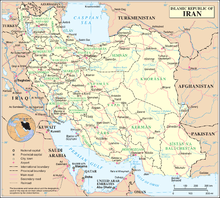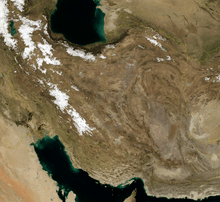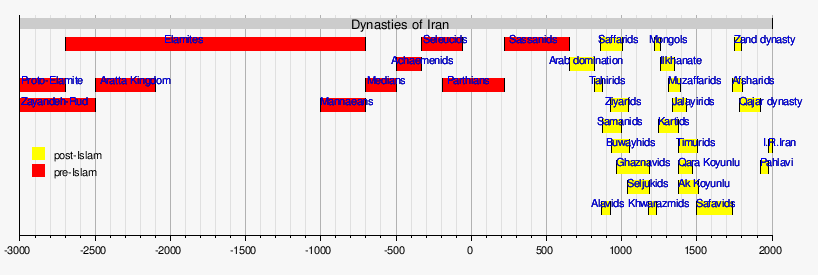Outline of Iran
The following outline is provided as an overview of and topical guide to Iran:


Iran – sovereign country located in Southwest Asia and the Middle East.[1] Iran is bound by the Gulf of Oman and the Persian Gulf to the south and the Caspian Sea to its north. Shi'a Islam is the official religion, and Persian is the official language.[2] Iran's population is about 83,500,000;[3] and is the 18th largest country in the world in terms of area at 1,648,195 square kilometres (636,372 sq mi). Iran is home to one of the world's oldest continuous major civilizations, with historical and urban settlements dating back to 4000 BC.[4][5][6] Throughout history, Iran has been of geostrategic importance because of its central location in Eurasia and is a regional power.[7][8] The political system of Iran, based on the 1979 Constitution, comprises several intricately connected governing bodies. The highest state authority is the Supreme Leader, currently Ayatollah Ali Khamenei.
General reference

- Pronunciation:
- Common English country name: Iran, archaic Persia
- Official English country name: The Islamic Republic of Iran
- Common endonym(s):
- Official endonym(s):
- Adjectival(s): Iranian
- Demonym(s):
- Etymology: Name of Iran
- International rankings of Iran
- 18th largest country
- 17th most populous country
- ISO country codes: IR, IRN, 364
- ISO region codes: See ISO 3166-2:IR
- Internet country code top-level domain: .ir
Geography of Iran

- Iran is: a country
- Location:
- Northern Hemisphere and Eastern Hemisphere
- Eurasia
- Asia
- Southwest Asia
- Middle East
- Iranian plateau
- Armenian highlands[9]
- Asia
- Caucasus (partly)
- Time zone: Iran Standard Time UTC+03:30, Iran Daylight Time UTC+04:30
- Extreme points of Iran
- High: Damavand 5,610 m (18,406 ft)
- Low: Caspian Sea −28 m (−92 ft)
- Land boundaries: 5,440 km







- Coastline: 2,440 km[10]
- Population of Iran: 79,966,230 people (2017 estimate) - 18th most populous country
- Area of Iran: 1,648,195 km2 (636,372 sq mi) - 18th largest country
- Atlas of Iran
Environment of Iran

Environment of Iran
- Climate of Iran
- Environmental issues in Iran
- Renewable energy in Iran
- Geology of Iran
- Protected areas of Iran
- Biosphere reserves in Iran
- National parks of Iran
- Wildlife of Iran
- Fauna of Iran
Natural geographic features of Iran
- Glaciers of Iran: None
- Islands of Iran
- Lakes of Iran
- Mountains of Iran
- Rivers of Iran
- Waterfalls of Iran
- Valleys of Iran
- List of World Heritage Sites in Iran
Regions of Iran
Ecoregions of Iran
Administrative divisions of Iran
Administrative divisions of Iran
- Provinces of Iran
- Counties of Iran
- Municipalities of Iran
- Counties of Iran
Provinces of Iran
Counties of Iran
Municipalities of Iran
Municipalities of Iran
- Cities of Iran
- Capital of Iran: Tehran
Demography of Iran
Government and politics of Iran
- Form of government: Islamic republic
- Capital of Iran: Tehran
- Elections in Iran
- Political parties in Iran
- Taxation in Iran
Branches of the government of Iran
Government of Iran
Executive branch of the government of Iran
- Assembly of Experts
- Elects the Supreme Leader
- Has the constitutional authority to remove the Supreme Leader from power at any time
- Supervises the Supreme Leader in the performance of legal duties
- Head of state: Supreme Leader of Iran, Ali Khamenei
- Head of government: President of Iran, Hassan Rouhani
- Vice President of Iran - anyone appointed by the President to lead an organization related to Presidential affairs. There are currently 10 Vice Presidents in Iran:
- First Vice President, Eshaq Jahangiri
- Vice President and Head of Atomic Energy Organization of Iran, Ali Akbar Salehi
- Vice President and Head of Environmental Protection Organization, Masoumeh Ebtekar
- Vice President and Head of Management and Planning Organization, Mohammad Bagher Nobakht
- Vice President for Executive Affairs, Mohammad Shariatmadari
- Vice President for Science and Technology and Head of Iran's National Elites Foundation, Sorena Sattari
- Vice President for Legal Affairs, Elham Aminzadeh
- Vice President for Parliamentary Affairs, Majid Ansari
- Vice President for International Affairs, Akbar Torkan
- Vice President and Head of Foundation of Martyrs and Veterans Affairs, Mohammad-Ali Shahidi
- Vice President and Head of Cultural Heritage, Handcrafts and Tourism Organization, Mohammad-Ali Najafi
- Vice President for Women and Family Affairs, Shahindokht Molaverdi
- Council of Ministers of Iran
- Ministry of Agricultural, Mahmoud Hojjati
- Ministry of Communications and Information Technology, Mahmoud Vaezi
- Minister of Cooperatives, Mohammad Abbasi
- Minister of Culture and Islamic Guidance, Ali Jannati
- Ministry of Defense and Armed Forces Logistics, Hossein Dehghan
- Ministry of Economic Affairs and Finance, Ali Tayebnia
- Ministry of Education, Ali Asghar Fani
- Ministry of Energy, Hamid Chitchian
- Ministry of Foreign Affairs, Mohammad Javad Zarif
- Minister of Health and Medical Education, Hassan Hashemi
- Ministry of Industries and Business, Mohammadreza Nematzadeh
- Ministry of Intelligence and National Security, Mahmoud Alavi
- Ministry of Interior, Abdolreza Rahmani Fazli
- Ministry of Justice (Iran), Mostafa Pour Mohammadi
- Minister of Labour and Social Affairs, Ali Rabei
- Ministry of Petroleum, Bijan Namdar Zanganeh
- Minister of Science, Research, and Technology, Reza Faraji Dana
- Ministry of Transportation and Housing, Abbas Ahmad Akhoundi
- Ministry of Youth Affairs and Sports, Mahmoud Goudarzi
Legislative branch of the government of Iran
- Majlis of Iran (unicameral parliament)
- drafts legislation
- ratifies international treaties
- approves the national budget
- Guardian Council
- 12 members
- 6 appointed by the Supreme Leader
- 6 elected by the Majlis
- Powers and responsibilities:
- Supervises elections
- Approves or rejects candidates for President, Majlis, and the Assembly of Experts
- Reviews all bills passed by the Majlis for constitutionality and compatibility with Islamic law, and approves or vetos them
- 12 members
- Expediency Discernment Council
- Appointed by Supreme Leader
- Main purpose is to mediate disputes between the Majlis and the Council of Guardians
- Also serves as an advisory board to the Supreme Leader
Judicial branch of the government of Iran
- Supreme Court of Iran
- Special Clerical Court - for trying Muslim clerics, and accountable only to the Supreme Leader
Foreign relations of Iran
- Iran-Arab relations
- Diplomatic missions in Iran
- Diplomatic missions of Iran
International organization membership
International organization membership of Iran The Islamic Republic of Iran is a member of:[1]
Law and order in Iran
Law of Iran
- Capital punishment in Iran
- Constitution of Iran
- Crime in Iran
- Human rights in Iran (1925–1979)
- Law enforcement in Iran
Military of Iran
Military of Iran
- Command
- Commander-in-chief: Supreme Leader of Iran, Ali Khamenei
- Ministry of Defence of Iran
- Commander-in-chief: Supreme Leader of Iran, Ali Khamenei
- Defense industry of Iran
- Forces (Iran has two armies)
- Army of Iran
- Navy of Iran
- Air Force of Iran
- Islamic Revolutionary Guard Corps
- Basij Resistance Force (paramilitary force. Compare with National Guard)
- Iran and weapons of mass destruction
- Military history of Iran
- Military ranks of Iran
Local government in Iran
Local government in Iran
- City and Village Councils of Iran
History of Iran
- Timeline of the history of Iran
- Current events of Iran
 |
_armour_(cleaned).jpg)
- Iran hostage crisis
- History of fundamentalist Islam in Iran
- Military history of Iran
- Timeline of the Iranian Islamic revolution
- Chahar-Ai-Ne (Persian چهاﺮآﻳنه )
- Plated mail
History of Iran, by period
Pre-Islam Iranian history
- Palaeolithic Era in Iran
- Archaeological sites in Iran
- Tappeh Sialk
- Jiroft culture
- Kura-Araxes culture
- Atropatene
- Arran (Caucasus)
- Shahr-i Sokhta
- Akkadian Empire
- Elam
- Mannaeans
- Aratta
- Kingdom of Pontus
- Urartu
- Neo-Assyrian Empire
- Neo-Babylonian Empire
- Aratti theory
- Aryan
- Indo-Iranians
- Iran naming convention
- Kassites
- List of ancient Persians
- List of kings of Persia
- Parthia
- Parthian Empire
- Arsacid dynasty of Iberia
- Arsacid dynasty of Armenia
- Arsacid Dynasty of Caucasian Albania
- Persian war elephants
- Median Empire
- Achaemenid Empire
- Seleucid Empire
- Parthian Empire
- Roman-Parthian Wars
- Sassanid Empire
- Byzantine-Sassanid Wars
- Persian Armenia
- Asorestan
Post-Islam Iranian history
- Islamicization in Iran
- Islamic Conquest of Iran
- Anglo-Russian Convention of 1907
- Treaty of Gulistan
- Treaty of Akhal
- Treaty of Zuhab
- Treaty of Turkmenchay
- Sallarids
- Ak Koyunlu
- Kara Koyunlu
- Safavids
- Qajar dynasty
- Ottoman-Persian Wars
- Russo-Persian Wars
Pahlavi and contemporary history of Iran
- Constitutionalist movement of Gilan
- List of Prime Ministers of Iran
- Anglo-Soviet invasion of Iran
- Persian Constitutional Revolution
- Persian Corridor
- White Revolution
- Human rights in the Imperial State of Iran (1925–1979)
- Human rights in the Islamic Republic of Iran (1979–present)
- Iran–Iraq War
- United States support for Iraq during the Iran–Iraq war
- United States support for Iran during the Iran–Iraq war
- 1988 Massacre of Iranian Prisoners
- Ahvaz Bombings
History of Iran, by subject
- History of science in Persia
- Military history of Iran
- Prime Minister of Iran
- Persianization
- Persian mythology
- Iranian continent
- Iranian Azerbaijan
- Iranian Kurdistan
- Iranian peoples
- Iranology
- Islamic Cultural Revolution
- University of Chicago's Persian heritage crisis
- Islam in Iran
- Islamicization in Iran
- Turko-Persian tradition
- Kayanian dynasty
Culture of Iran
- Architecture of Iran
- Cuisine of Iran
- Ethnic minorities in Iran
- Festivals in Iran
- Languages of Iran
- Media in Iran
- Museums in Iran
- National symbols of Iran
- Coat of arms of Iran
- Flag of Iran
- National anthem of Iran
- People of Iran
- Prostitution in Iran
- Public holidays in Iran
- Records of Iran
- Religion in Iran
- List of World Heritage Sites in Iran
Art in Iran
- Art in Iran
- Cinema of Iran
- Literature of Iran
- Music of Iran
- Iranian musical instruments
- Television in Iran
- Iranian theatre
Economy and infrastructure of Iran
- Economic rank, by nominal GDP (2007): 29th (twenty-ninth)
- Agriculture in Iran
- Banking in Iran
- National Bank of Iran
- Communications in Iran
- Internet in Iran
- Companies of Iran
- Currency of Iran: Rial
- ISO 4217: IRR
- Economic history of Iran
- Energy policy of Iran
- Health care in Iran
- Industry of Iran
- Mining in Iran
- Petroleum industry in Iran
- Tehran Stock Exchange
- Tourism in Iran
- Transport in Iran
- Airports in Iran
- Rail transport in Iran
- Roads in Iran
- Urban plans in Iran
- Water supply and sanitation in Iran
Education in Iran
See also
| Persian language edition of Wikipedia, the free encyclopedia |
- Index of Iran-related articles
- International rankings of Iran
- List of international rankings
- List of Iran-related topics
- Member state of the United Nations
- Outline of Asia
- Outline of geography
References
- "Iran". The World Factbook. United States Central Intelligence Agency. July 15, 2009. Retrieved July 23, 2009.
- قانون اساسی جمهوری اسلامی ایران (in Persian). Retrieved 23 January 2008.
- Iran amar.org.ir Retrieved 30 April 2020
- Xinhua, "New evidence: modern civilization began in Iran", 10 August 2007, retrieved 1 October 2007
- Iran Daily, "Panorama", 3 March 2007, retrieved 1 October 2007 Archived January 24, 2008, at the Wayback Machine
- Iranian.ws, "Archaeologists: Modern civilization began in Iran based on new evidence", 12 August 2007, retrieved 1 October 2007 Archived June 25, 2008, at the Wayback Machine
- parliament.uk, "Select Committee on Foreign Affairs, Eighth Report, Iran, retrieved 1 October 2007
- IRAN @ 2000 and Beyond lecture series, opening address, W. Herbert Hunt, 18 May 2000 Archived 3 January 2010 at the Wayback Machine, retrieved 1 October 2007
- "Armenian Highland". Retrieved 28 February 2015.
- Iran also borders the Caspian Sea, a remnant of the ancient Paratethys Sea.
External links
- The President of Iran
- Iran Electoral Archive
- The Majlis (Legislature) of Iran (in Persian)
- Iran.ir
- Persian language (Persian)


- Outline of Iran at Curlie
- First Iranians: Reference Articles on Iran By Manouchehr Saadat Noury
- Iranian Innovations
- Faces of Iran: The World in One Nation (a sequence of still photographs, showing the richness of the ethnic and religious diversity of the people of Iran), YouTube.
- Rageh Inside Iran, a BBC Four production, 17 February 2007,
- Farhad Nabipour, From Persia to Iran, Part I, AMIR Productions, 4 November 2006 (slide show accompanied with Pink Floyd and Persian music — 28 min 8 sec), Google. Highly recommended!
- Farhad Nabipour, From Persia to Iran, Part II, AMIR Productions, 10 November 2006 (slide show accompanied with Pink Floyd and Persian music — 21 min 46 sec), Google.
- Some Iranian folk-songs sung by Shusha Guppy in the 1970s:
Silver Gun (from Shiraz), Wheat Flower (a harvest song), The Rain (from the Gilan Province), The Stars in Heaven (from Shiraz), On Top of the Hill (from Shiraz), The Silken Handkerchief (from the Fars Province), Darling Leila (from the Gilan Province), I Have Come to Ravish My Heart (from the Lorestan Province), The Lor Youth (a Bakhtiari-Tribe song), Lullaby (from Gorgan), Girl from Boyer-Ahmadi Tribe (from the Kohgiluyeh and Boyer-Ahmad Province), My Beloved is Short (from the Fars Province), The Water Pipe, You Must Come to Me (from Mamasani County), Darling Dareyne (from the Mazandaran Province).
For further details see: Iranian. - Nir Rosen, Selling the War with Iran, The Washington Note, Thursday, May 1, 2008, .
- The Second International Festival of Peace Poetry, Iran, 16 May 2009: (English), (Persian).